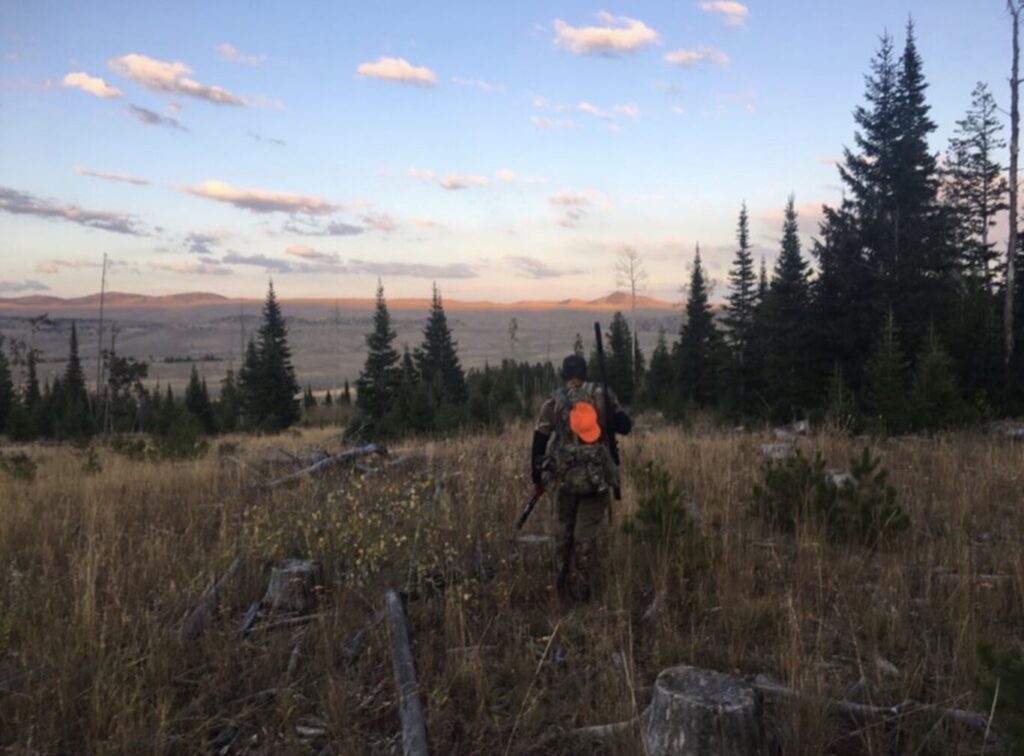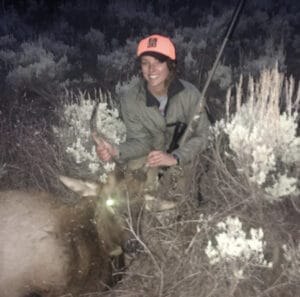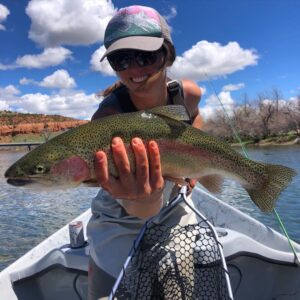There I was…
A lazy October sunset cast soft shades of pink across the rolling foothills of southwest Wyoming. I was walking quietly, mindful of my position in the breeze. Mindful of the sound of my boots on the dead grass, sharply aware of the frozen earth below, the dark woods around, and the herds of elk that I knew were moving across the vast land. I thought back to earlier that month when I watched a doe antelope through my rifle scope. The world suddenly went still as I placed a shot right through her heart. In that instant I stepped into the role of a hunter, a working part in a complex system of life, resources, and space. In that instant, my life changed.
I grew up in coastal New England where hunting was an afterthought. Occasionally a gunshot would ring through the autumn woods. Wild food meant locally caught seafood, and land-bound meat came from small, neighborhood farms that raised animals humanely. When I moved out to Colorado for college I struggled with the idea that the mouth-watering treat of a post-hike burger came with the omnipresent knowledge that every bite I took supported the cruelty, health problems, and the massive environmental footprint that exist behind the meat industry. I was raised to have a connection to the food on my plate. The plastic packages of meat under fluorescent grocery lights felt so wrong to me.
Years later, I accepted a job in Kemmerer, Wyoming on a wildland fire engine. I found myself moving into a single-wide trailer on the edge of town where my new neighbors included a herd of antelope. On sunset BLM wildlife drives with my coworker, Kolten I learned things I never considered in five years of undergraduate ecology studies.
Centuries of human intervention make it clear, even places as wild as Wyoming, cannot hide the impact of the human species. Whether it’s unhealthy explosions of certain plant or animal populations and the catastrophic decline of others, or the presence of roads, fences, and infrastructure; there is a direct impact on habitat space and migration routes.
I always considered hunting as a way to ethically source meat, but never as an active part in scientifically-backed conservation. Putting healthy, local, very free-range meat on the table is an obvious plus, though. Population control from hunting is a necessity of conservation – a necessity that in turn provides significant funding for state agencies to rely on. The funding supports conservation studies, projects, and outreach efforts to help the very places where the deer and antelope play.
To say this conservation notion blew my mind open a bit is an understatement. I moved from the Colorado front range where vegan cafes butted up against cattle farms, so I had never gained much insight on alternate ways to source my meat. As I would drink my coffee in the morning sun and stare at the neighbor antelope, I began to seriously consider that the answers to my questions might be right in front of my face.
Luckily, I was in the best possible place to start my hunting journey. In my first week of work my engine captain, a vaguely scary ex-wrestler, called me into his office. Fearing the worst, I was certain he was going to reprimand me on my push-up form or chainsaw skills. Instead, Cody handed me a flyer for a fantastic women’s sporting group – Artemis – and opened the doors to a deeply fulfilling mentorship. It was not long before I found myself swept up in a life of target practice, hunter safety classes, scouting missions, and trail cam footage.
The next year, when the aspens put on their golden show and the elk bugles rang in the foothills, I was ready. I spent all summer religiously practicing with Kolten’s 6.5 Creedmoor until I certainly could place a killing shot. I drew a doe antelope tag and picked up general deer and elk licenses at the gas station, hoping I could fill at least 1 out of 3 tags. I also went down to the local hardware store and purchased a ridiculous orange hat. It was so bright it warranted several people to pretend to go blind around me.
I drove along snow-speckled mountains to the cluster of wall tents that was elk camp. There, I was greeted warmly by Cody’s hunting buddies and shook the rough hands of a group of men who seemed delighted to have a newcomer. Everyone had his own opinion about which gun or caliber was best, what time of day to hunt, or whether or not wearing camo was actually worth it, but the feeling of being welcomed into a new community was ubiquitous. When the sun started sinking low in the sky, we made plans, shouldered our guns, and the group split off to their respective sections of land.
I set out with Cody for a dark patch of woods, crept back in the bushes, settled in, and waited. And waited. My right foot went numb. Then my left. I nearly pulled a muscle in my hip as I tried to uncross my legs while making as little noise and movement as possible. As I was about to give up on the meditation that is waiting for elk, Cody’s eyes went wide as he registered something behind me that could only mean one thing.

The elk vanished as quickly as he had appeared. Silent, almost ethereal. A true resident of this land, knowing exactly how to melt back into the dark trees as soon as danger laid its eyes on him. Heart pounding, I crept up the ridge where he had vanished and came to stop on a knoll surrounded by dark timber. I couldn’t see the elk, but I could feel the presence of the herd all around me. Their musky, earthy smell mingled with the sharp sage in the cold air. I could hear the dull thud of their hooves striking the ground as they shifted uneasily. We remained there for a while, the elk and I, feeling the meaning of each other’s presence on the land. The sun sank below the western horizon, and, as twilight settled on the land, I felt the animals move off.
Cody joined me and we began chatting about plans for the following morning. We casually scanned the woods around us with our binoculars and took in the last of the fading sky. As elk disappear with the shifting shadows, they materialize just the same. There he was. A young bull, in a small clearing about 200 yards away, gazing right back at me through the glass.
Months of preparation immediately took over and I moved through a trance. Uncover the scope. Set up my shooting sticks and rifle. Put my sights on him. Put a bullet in the chamber and take the safety off. Aim. Breathe.
A vast wave of clarity washed over me as the world slowed down for just a few seconds. All I could hear were my heartbeats and the wind in the darkening sage.
He was young, a spike, but he stared back at me with an unrelenting gaze that held the millennia of wisdom that comes from a truly wild thing evolving with the land. One of the fundamental rules of biology is that no living thing wants to die. Yet, wild animals seem to accept their inevitable death, and their subsequent place in the ecosystem, much better than we humans. The way he stood, broadside and still, it almost seemed as if he knew and submitted to what was coming. I sent a silent thank you across the darkening sage to him. Then, I squeezed the trigger.
I barely even heard the shot. I didn’t flinch and watched through the scope as bullet met heart. The spike arched his back and backed up a few feet. I put another bullet in the chamber, ready. I recalled watching an antelope I had harvested earlier that month, run over 100 yards before it dropped, and I prayed that this elk wouldn’t do the same. I placed two more shots as my hammering heart drowned out the sound of the rifle, and then he was down.
Then, my hands shook. I let out a gust of air and sat back in the grass and the world started moving again. Shock. Sadness at taking a life. The excitement that I had harvested my first elk and slight disbelief that I actually did it. Pride and extreme gratitude. They all washed over me at one time. Cody whooped and congratulated me and let me go ahead to the body while he called in the rest of the guys over the radio.
I set out alone across the sage, not even thinking to curse myself for not bringing a headlamp as the twilight melted into the night.

All I could focus on was finding the body in its final resting spot. All things considered, it’s not a bad place to end a life. Under the vast Wyoming sky and a gorgeous sunset, among fragrant sage, the pines whispered a eulogy. When I came upon his spot, I sunk my hands into the still-warm fur as a few big, salty tears splashed onto his flank
Then it was time for work. Before I knew it, I was surrounded and overwhelmed with congratulatory remarks and the collective excitement of a successful hunt. Nearly all the elk camp members showed up to help. They seemed just as ecstatic as I. Countless hands became available to hold up elk parts, show me the best way to remove the backstraps, hold lights and legs, and stuff meat into game bags. That night, surrounded by people who had been strangers just a day ago, I felt the collective support of a strong community of hunters. Hunters, ecologists, wildlife lovers, conservationists, citizens of the land.
That night was cold. The air held the promise of an early snowstorm, but I rested warm and comfortable in my sleeping bag. Outside, a brilliant display of stars lay scattered across the sky, and a pack of coyotes yipped in jubilance as they celebrated the remains of the elk carcass.
Living Wyoming Wild
I consider myself incredibly lucky to live in a close connection to the vast public lands that Wyoming is famous for. Herds of deer and elk browse in my neighborhood, and as I walk in the shadow of the Tetons, my footsteps follow the contours of a clear river and the tracks of wolves. I feel fortunate to share this land with the animals that call it home. Whenever I sear a tiny antelope steak or invite friends to gather around a big pot of elk chili, I extend thanks. With every bite, I taste the blood, sweat, and tears that went into the hunting and processing of the animals. It isn’t easy to kill an animal, but with warm blood on my hands, I know that I took part in every step of the job that rewarded me with a freezer full of meat.
Hunting has become so much more to me than just filling my freezer. I know this land and animals, studying it the way I’ve learned to study bugs under river rocks while fly fishing. I’ve spent hours watching them through binoculars or trekking silently across the foothills in pursuit, taking in their movements, smells, sounds, and life in a relationship that is more intimate and meaningful than I ever could have imagined. I am bound by this connection to protect it.
Robin Wall Kimmerer said, “just as all beings have a duty to me, I have a duty to them. If an animal gives its life to feed me, I am in turn bound to support.” I am part of a complex ecosystem, an ecosystem that has drilling sites, fences, and roads, but also passionate individuals who do everything they can to help the wild animals we share this land with. And this is the role I play: to love, to hunt, to protect.
Why WWF?
Wyoming Wildlife Federation provides a platform for the people who actively celebrate our public lands and wildlife. There is no arguing the impact humans have made on the ecosystem, but efforts made by WWF and other nonprofits play an important role in protecting the land we use and the creatures we share it with. With a strong background in hunting and angling, WWF speaks to the people who know, use, and love this land in a multitude of ways, raising an army of passionate individuals ready to fight for scientifically-managed wildlife conservation. It represents everything that the community who welcomed in a clueless first-time hunter stands for.
Recipe: Elk stew
Elk stew is my favorite thing to make in the slow cooker. Nothing beats the smell of coming home to a dinner cooking that you prepared that morning.
1.5 lb of elk meat or venison, cut into 1” cubes – I use the less tender cuts of meat that would generally go in the grinder.
2 cups Yukon gold potatoes, cut into 1” cubes
1 medium-sized yellow onion, diced
2 cups of baby portobello mushrooms, quartered
1.5 cups of bell peppers, cut into 1” pieces
1 cup carrots, sliced
3-5 cloves of sliced garlic
Sliced ginger – about 1.5” worth
Tomato paste – I use a whole tube (4.5 oz)
2 tablespoons of butter
Spices to Taste:
Salt
Pepper
Thyme
Rosemary
Oregano
Red chili flakes
1 cup of stock (vegetable or beef is fine)
1 cup of red wine
Instructions
Cut the meat into 1” cubes. Heat up olive oil in a cast-iron pan and sear the cubes until they are just brown on all sides (no more than 5 minutes).
Layer vegetables, meat, and spices in a slow cooker and cover in tomato paste. Pour stock and wine over top. Cook on low for about 7-8 hours or until the meat is tender. Add flour to thicken the stew if desired. Goes great with wild rice, red wine, and a snowy night.
About Clea

